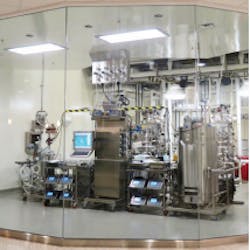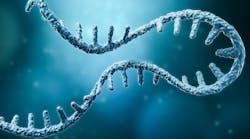Biopharma is absolutely not for the fainthearted. That's the big lesson that many new entrants are learning after some bruising early experiences. Although biopharma is certainly one of the pharmaceutical industry's most attractive sectors, new players regularly trip over its many complexities. Whether they are financially strong contenders from related industries medical product makers, for instance or traditional pharma companies that are shifting resources toward biologics, the operational hurdles are the same.
The hard fact is that biopharma operations are significantly more complex than traditional pharma operations, and they have little in common with the production of small-molecule drugs. For a start, building a new biopharma facility takes longer than for chemical or finished-dosage plants (typically four years compared with two years for conventional pharma plants) and requires a much higher investment (capital expenditure is seven to ten times greater). No surprise, then, that companies with business processes tailored to small molecules or non-pharma products have found these capital projects difficult to manage.
New contenders getting into biosimilars specifically need to develop production processes to ensure that product quality and cost are comparable to those of originator drugs. But primary production processes are complex and entail many input parameters, requiring in-depth expertise in process development. In biopharma, far more so than in traditional pharma, product quality is a function of production-process development and manufacturing.
Newcomers also find it tough to gain access to patents on the molecule itself and tougher still to circumvent intellectual property relating to production technology. Companies that fail to tackle these issues may have to shut down development.
What the newest players are learning is that they must quickly build up expertise in completely new technologies and create a biopharma culture that helps them attract and retain the best people. To be truly competitive in biopharma, newcomers must demonstrate much higher levels of skills and more sophistication in development, manufacturing and testing. The last thing they need is the talent drain that many of them find themselves suffering from.
THE DETAIL ON WHY BIOPHARMA IS DIFFERENT
So, what is required to overcome these hurdles? Success in biopharma starts with understanding the technological differences that make the sector's operations so complex. The exhibit provides an overview of the technological differences between biologics and small molecules and the implications for biologics. In fact, the marked differences have far-reaching implications for production, supply chain, labor and talent, and science and technology. We examine each of these areas:
Production
Production of biologics is a highly technical, multistep process that entails very long lead and cycle times. For example, consider the process required to produce a recombinant monoclonal antibody (mAb) by mammalian cell culture (mAbs are the type of molecule used in several blockbuster biologicals, meaning those that have annual sales of $1 billion or more).
Cell line
Manufacturing is based on genetically modified living organisms that express the protein. Molecular biologists prepare the DNA (the software) coding for the mAb, and cell biologists insert the DNA into living cells by transfection (a recombinant DNA technology). Cell biologists also apply sophisticated methods to select clones for high quality and productivity. The lead time from the design of the genetic code to the final clone is 9 to 15 months.
Cell banking
To enable reproducible results, modified cell clones have to be frozen, stored at -120 degrees C or below, and then thawed for use. This process, carried out by a cell biologist, is called cell banking. It provides the master cell bank and working cell banks. These banks will be critical over the lifetime of the product because they are its single source. It takes three to six months to prepare, test and release a master cell bank.
Process development
Cell clones need to grow in number and reach sufficient volumes before it's possible to start producing the protein (e.g., a mAb). To enable this, cell culture technologists must undertake the challenging endeavor of developing a production process that delivers consistently robust growth, high titer, high yield, and reliable product quality.
Manufacturing the drug substance
This production stage entails cell cultivation and purification. Once, blood or serum were used as the media in which cells were cultivated, but nowadays manufacturers use highly complex, chemically defined media that mimic the properties of those original media. The cultivation and the protein fermentation processes are run in stainless-steel vessels or disposable bags. Because protein molecules are sensitive to heat, pH and organic solvents, complex and expensive purification technologies must be applied technologies such as affinity chromatography, ultrafiltration (UF), and tangential flow filtration (TFF). It takes five to seven weeks to go from vial crack to final formulated bulk.
Production of final drug products
Biopharmaceuticals are typically delivered to patients by injection. This is because the drugs degrade in the digestive system (owing to pH sensitivity and protease, for example) and because of their size (most therapeutic proteins are not able to permeate mucosae). Delivery by injection requires the use of medical devices, such as prefilled syringes, dual-chamber capsules, or injection pens. The high quality standards and stringent sterility of the primary packaging needed for this delivery method drive higher costs of goods sold and can compromise patient safety if operations are mismanaged. The recent increase in warning letters to sterile facilities from the U.S. Food and Drug Administration, such letters now make up about 25 percent of all letters, compared with approximately 10 percent in previous years, speaks volumes about the extent of the quality challenges.
SUPPLY CHAIN MANAGEMENT
Planning and forecasting are especially critical in biopharma, given the complexity and long lead times of its production processes and the less dependable outcomes of production. The long lead times required to respond to demand make it essential to build in risk mitigation strategies. In addition to the supplies for the final product, it's also critical to properly source the raw materials used to prepare media for cell growth as well as the resins used to purify the product. These supplies are very often controlled by a single source and produced infrequently in large batches. Because they are complex by nature, there is a high risk of contamination. Quality control labs must devote extensive effort to testing and releasing raw materials, addressing the environmental burdens, and understanding how the materials will perform when used in manufacturing.
LABOR AND TALENT
The expertise required for biopharma is very different from what traditional pharma players are accustomed to. Development, manufacturing and testing of biopharmaceuticals require greater technological sophistication because complex, sensitive molecules are produced using live, genetically engineered cells. These molecules are high-value products with short shelf lives.
Biopharma technicians require more extensive education and training in specific areas than do their counterparts in traditional pharma. They need to be full-fledged scientists with in-depth technical expertise in process sciences if their companies are to develop production processes that meet product quality requirements and yield expectations and that are suitable for the facilities.
Moreover, employees in support functions such as quality must be even more qualified than their counterparts in small-molecule operations so that they can work with more variable processes. The larger size and complexity of molecules require many more scientific tests, including tests that use living cell cultures. In-depth scientific knowledge is required to interpret the test results, especially in the case of development work or deviations during the commercial process. Employees work is more labor intensive, because investigations and microbiological tests are more numerous and require more time.
Biopharma innovation means addressing both production processes and facilities design. In less than two years Boehringer Ingelheim increased productivity fourfold at its newly acquired facility in Fremont, California.
These unique requirements for biopharma technicians and support teams mean that the availability of talent can be the rate-limiting step for successful growth, transformations and business expansions.At the same time, a biopharma culture is essential to get the most out of this talent. Many new entrants have found their efforts undermined by a talent drain. In practice, a small community of experts provides much of the top talent at biopharma companies. The culture of the typical biopharma company often resembles that of an Internet start-up, with an informal and nonhierarchical work environment. This is a factor that acquiring companies must take very seriously; if they do not offer their new biopharma experts a work environment that suits their needs, those prized professionals are likely to quit. In at least two recent instances, aggressive efforts to assimilate an acquired company have stifled creativity and motivation in previously innovative development departments.MANUFACTURING SCIENCE AND TECHNOLOGY
The biopharma manufacturing function cannot carry its burdens alone; it has to be supported by experts with more-extensive scientific backgrounds. These experts, in teams called manufacturing science and technology (MSAT) or process sciences, provide expertise in the development of robust production processes and in scaling them up from the lab to manufacturing. They specialize in troubleshooting, based on their knowledge of more than 100 input parameters in biopharma manufacturing. To investigate the root causes of deviations from specified process or product parameters, these MSAT experts use smaller-scale models to mimic large-scale processes. As biopharma manufacturing becomes more global, expertise in product transfers can be found in both internal and external networks.
The engineering and technology functions are challenged by the need to tailor the facility's design to the production process, including sterile design and robustness. Designers also have to deal with having few common platforms for the production of molecules, which means that facilities must often be designed to fit to the production process rather than vice versa.
These differences make it imperative for biopharma companies to recruit highly qualified workers and provide high levels of training and qualification. Locating facilities close to universities and industry clusters (for example, on the East and West coasts of the United States or in Germany, Switzerland, and lately Singapore) is critical to accessing the right kinds of talent.
MOVING FROM SCIENCE TO INDUSTRIALIZATION
Beyond the technological differences, new entrants must recognize that the biopharma industry is less mature than traditional pharma. Then, they have to work to understand and address the implications of that fact not least of which is the gradual industrialization of the sector.
The biopharma industry has enjoyed years of strong growth by focusing on technology improvements such as yield increase. Its leaders have enjoyed successful career paths thanks to their sophisticated technical skills and strong scientific backgrounds. Because of their emphasis on technical expertise, these leaders typically focus on pursuing scientific solutions to improve performance, rather than optimizing business processes and operations. Whereas their counterparts in traditional pharmacos have experienced a decade of network optimizations and site transformations, biopharma company leaders have limited experience with lean practices and are often skeptical about its benefits.
That has to change. As biopharma moves steadily from the scientific frontier into industrialization, the industry will be forced to confront the same overarching challenge faced by other businesses: maintaining competitiveness by ensuring acceptable cost, quality and delivery. The required levels of performance in each of these dimensions is likely to become considerably more demanding because of globalization, increasing competition and the rise of biosimilars.
THE PATH TO SUCCESS
So, are there common strategies that biopharma's newcomers can apply to ensure success? Yes and no. The ways in which each new contender handles the differences between pharma and biopharma operations will depend on its starting point:
Companies can improve agility by designing flexible facilities and carefully considering the use of single-use systems.
Pushing to the next level of innovation also means addressing both production processes and facilities design. An in-depth scientific analysis of the production process, followed by the optimization of the process (for example, down-scale modeling lab and media optimization), can lead to very significant yield increases and help to keep the quality of the large, complex biomolecules within the specified parameters.- A biosimilars player that is trying to carve out a larger share of the market should recognize that mastering technology and innovation is just a first step. The company may also need to pursue lean programs to ensure agility, speed and launch excellence.
Companies can improve agility by designing flexible facilities based on stainless steel, disposables, or hybrid systems to suit specific product and market conditions. Advanced approaches include employing new manufacturing techniques; replacing equipment that is difficult to clean or repair; and using disposable, single-use equipment when feasible. Companies can also simplify existing facilities or pursue automation to address the higher complexity of biopharma operations by offering technical solutions to reduce errors.
- An ambitious but inexperienced new entrant from another industry should partner with or acquire a biopharma company to speed up the learning process. Robust risk-mitigation strategies related to the biopharma supply chain should be central to such partnering or merger moves. These strategies can include internal solutions such as improving network design and inventory management, as well as external approaches such as optimizing the selection and management of CMOs.
A CMO should put forward a value proposition that offers leadership in technology and operations or that focuses on low cost. In either case, the CMO will need to grow so that it can meet customers evolving demands (such as speed to market, high-tech solutions, and proximity to market). There is much to be learned from the biopharma companies that have geared their manufacturing plants for growth. They have increased their capacity for individual molecules, as well as their ability to run multiple product lines and respond quickly to the needs of a volatile market all without compromising quality. Some companies have increased productivity fourfold and tripled the complexity of their product lines while reducing product transfer times from 18 to 9 months.
Understanding what is different about biopharmaceuticals is just the starting point for success in the complex business of biopharmaceuticals operations. The basic technologies used in the sector are likely to evolve significantly in the coming years, with the arrival of important new technologies and step changes in the performance of existing ones. The right strategy, combined with strong operational capabilities, will constitute vital ingredients for success in the sector. Managers must assemble and apply highly specialized expertise in all aspects of operations, whether to ensure flexible, high-yield production of high-quality biomolecules or to attract and retain the right talent to drive technology and innovation to its next levels.








